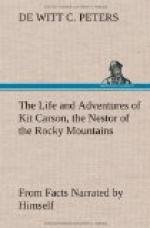In the following spring Kit Carson, accompanied by only one trapper, started out to hunt the streams in the vicinity of Big Snake River. The Utah nation of Indians inhabit this country; and, with them, Kit Carson stood on a friendly footing. The business of trapping was therefore carried on without fear of molestation. The labors of the two were crowned with great success.
Loaded with a full cargo of fur they soon after set out for Robidoux’s Fort, which they reached in safety, selling out their stock to good advantage.
Kit Carson made only a short stop at this Fort. As soon as his fur was disposed of, he immediately organized a small party consisting of five trappers and made a journey to Grand River. After thoroughly trapping this river, he established himself at Brown’s Hole on Green River for the winter. Early in the spring he returned with the same party to the country of the Utahs and hunted there for some time. He then went to the New Park, where they finished their trapping operations and returned to Robidoux’s Fort. Here Kit again found a purchaser for his furs; but, the prices at which he was obliged to sell them, did not at all please him. Within a few years, the value of beaver fur had greatly deteriorated. This was caused by the slow demand which had gradually ruled at the great emporiums of Europe and America. The skill of the manufacturer had substituted a material for the making of hats which, while it was cheaper, pleased the great race of hat-wearers. The beaver itself was becoming scarce, owing to their being so diligently hunted. It was evident to Kit Carson and many of his mountaineer companions that their occupation was gradually becoming less profitable and that it would soon drive them into other employments. Acting upon this impression Kit Carson, accompanied by “Old Bill Williams,"[14] William New, Mitchell and Fredericks, a Frenchman, started for Bent’s Fort, which was then located on the Arkansas River near a large forest of cotton wood trees, and which is, even at this day, known as the “Big Timbers.” The party struck the river at a point about one hundred miles above the Fort, where, in later years, was built a settlement called St. Charles.[15]




